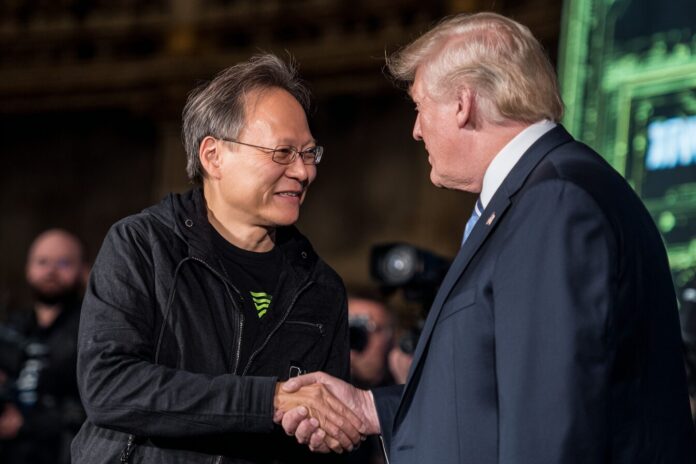The complex intersection of technology and politics has never been more evident. In an unexpected reversal, President Donald Trump abandoned his plan to break up Nvidia after an influential meeting with the company’s charismatic CEO, Jensen Huang. This decision not only redefined tech policy but also underscored the power of direct dialogue between government leaders and industry innovators.
Most importantly, this shift in policy highlights the intricate balance between regulating market competition and safeguarding national technological leadership. Because the stakes are high in today’s AI-driven economy, the details of this meeting continue to be closely scrutinized by industry analysts and policymakers alike.
The Initial Threat: Breaking Up Nvidia for Fair AI Competition
In recent years, the United States has faced a surge of innovation in artificial intelligence that has raised concerns about market monopolies. Therefore, President Trump considered dismantling parts of Nvidia, hoping to stimulate a more competitive landscape among AI chipmakers. His initial rationale was that breaking apart a dominant market force could encourage fresh market entrants and spark robust technological advancements.
At a high-profile Washington AI summit, Trump admitted his aggressive stance by stating, “I said, ‘Look, we’ll break this guy up,’ before I learned the facts here.” This remark echoed his typical propensity for immediate action. However, seasoned industry advisors soon clarified that the semiconductor sector is unique. Besides that, they stressed that the sophisticated nature of chip manufacturing involves decades of innovation, complex supply chains, and international partnerships that a simple breakup could disrupt. For further reading on these challenges, see Business Times and Economic Times.
Why a Breakup Was Deemed Unfeasible
Upon a deeper evaluation, government advisors explained that breaking up Nvidia was not only difficult but could also undermine the country’s competitive stance in global tech. Because Nvidia has built a substantial lead over its rivals, any forced separation would take years to reverse. Most importantly, technical experts warned that splitting the company could unravel decades of strategic investments and innovation.
Furthermore, advisors highlighted that semiconductor research and development is not something that can be arbitrarily segmented. In addition, the company’s extensive network of supplier contracts and long-term partnerships makes any structural upheaval incredibly challenging. Therefore, even the idea of a breakup was seen as a risky policy move that could have long-term negative repercussions for U.S. leadership in artificial intelligence.
The Turning Point: Jensen Huang’s Persuasive Leadership
The dramatic turnaround in policy occurred during a pivotal meeting between President Trump and Jensen Huang. Unlike many policy debates that transpire behind closed doors, this encounter was characterized by frank discussions and technical clarity. Huang employed clear language to illustrate the dangers of dismantling a technological powerhouse. Because his insight was rooted in years of practical experience, he effectively communicated why a breakup might harm American competitiveness in a fast-evolving global market.
Besides that, the meeting was emblematic of the growing influence that industry leaders hold in policy formulation. Huang detailed how Nvidia’s integrated approach to innovation was essential for both robust research and market stability. As reported by WebProNews, President Trump was not only receptive to this perspective but also visibly swayed by Huang’s confident demeanor. Consequently, Trump later praised Huang’s accomplishments, remarking during a summit, “What a job you have done,” a clear nod to the CEO’s persuasive influence.
Policy Ripple Effects: AI Chips, China, and U.S. Competitiveness
Therefore, the implications of the Trump-Huang dialogue extended well beyond antitrust concerns. In the wake of their meeting, United States policy experienced a subtle yet significant shift. One critical change was the relaxation of export restrictions on Nvidia’s H20 AI chips to China—a move that signaled a welcome easing of previously rigid trade policies. For more details on this decision, refer to the Almendron report.
Most importantly, this policy adjustment has stirred debates among economists and tech experts. While some commend the enhanced dialogue between the U.S. and China, others caution that such moves might compromise national security. Because maintaining America’s technological advantage is paramount, policymakers now face the dual challenge of fostering innovation while balancing geopolitical risks.
Looking Ahead: Future Implications for Tech Policy and Competition
The Nvidia saga offers valuable lessons for the future of tech regulation. Most importantly, it underscores that direct, pragmatic communication between industry giants and government officials can lead to more nuanced policymaking. Because the technology sector involves multifaceted challenges—from supply chain dynamics to international trade—future policy decisions must evolve in tandem with industry realities.
Furthermore, this episode signals that American tech policy may move away from blunt antitrust measures toward more sophisticated strategies combining competitive fairness with national security. Therefore, future dialogues and negotiations, reminiscent of the Trump-Huang meeting, could set new benchmarks for how regulatory decisions are made in the rapidly advancing digital economy. In addition, as AI innovation accelerates globally, maintaining open channels of communication between sectors is likely to be the cornerstone of sustainable growth.
Conclusion: Balancing Innovation and Regulation
In summary, the reversal of Trump’s initial plan to break up Nvidia illustrates the intricacy of regulating a high-tech industry that is both dynamic and interconnected. Because the challenges involved are technical, economic, and geopolitical in nature, simplistic solutions are rarely effective. Most importantly, this case emphasizes that successful policy outcomes often result from respectful and insightful dialogue between government and corporate leadership.
As we look ahead, the interplay between innovation and regulatory oversight will continue to be a critical point of focus. Therefore, nurturing an environment where strategic conversations can flourish will be essential to ensure robust competition while preserving national interests. The Nvidia episode, enriched with lessons learned and reinforced by strong industry-government ties, offers a blueprint for future policy deliberations in an era defined by rapid technological change.



